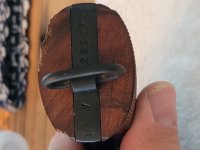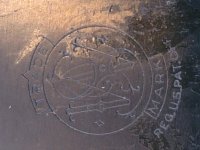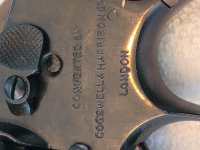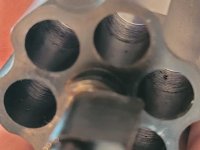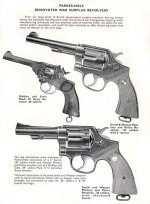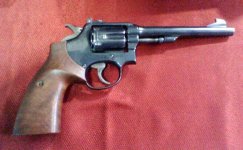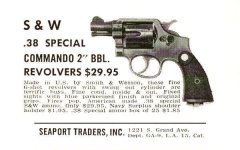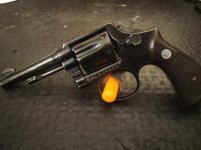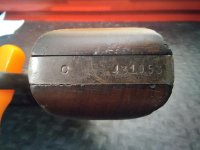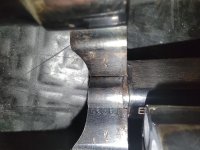You are using an out of date browser. It may not display this or other websites correctly.
You should upgrade or use an alternative browser.
You should upgrade or use an alternative browser.
help me identify this S&W
- Thread starter Td313
- Start date
Register to hide this ad
DWalt
Member
Without going into great detail, it is a converted WWII British Service Revolver (BSR) made by S&W. It was originally chambered for the .38 S&W cartridge which the British called the .380 Revolver, Mark I or Mark II. It is shorter and has a slightly larger diameter than the American .38 Special cartridge. These are often called “Victory Models” as they have a V prefix added to the serial number. When these revolvers were surplussed out by the British military beginning in the mid-1950s, many thousands were bought up at scrap iron prices by arms dealers, who converted them to accept .38 Special cartridges by simply drilling the cylinders deeper. Many thousands of these converted Victories were sold by mail order in the USA at cheap prices during the 1950s-1960s. Most of those converted in the US had their barrels shortened from 5” to 2”. There were also similar caliber conversions made in England for sale in the US by some British gunmakers. That is what you have. C&H was one of those British gunmakers. The English level of workmanship was usually of higher quality than those done in the US by numerous random machine shops. Your revolver can be used with both .38 Special and .38 S&W cartridges, but the latter are difficult to find today. Also, many of the British-done conversions had barrels shortened from their original 5” length to 3-1/2”. You might check your gun’s barrel length. They are generally not collectible and do not have any special value beyond their use as utility shooters.
Last edited:
I have one of the C&H conversions, 3 1/2" barrel...It's a neat gun... ...Ben
...Ben
Targets Guy
US Veteran
I have a C&H conversion, 3 1/2" barrel as well. It was a pre-Victory .38/200 BSR which was converted to a .38 special. Terrific shooter. I use it to hunt English walnuts.
 what gas stations are open right now near me
what gas stations are open right now near me



 what gas stations are open right now near me
what gas stations are open right now near me


When is the season on walnuts where you live?
Welcome to the forum!
The British cartridge is also known as the .38-200 because of its 200 gr bullet. The same cartridge by S&W uses a lighter bullet except for their old 200 gr Police load.
Has yours been converted to target sights, cartridge conversion to .38 Special or both?
As DWalt posted the British cartridge conversions are done correctly by usually sleeving and boring the chambers and usually barrel to proper .38 Spl bullet diameter and case diameter which are both different from the British cartridge dimensions. This means you’ll not be able to shoot both cartridges BUT you will have superior accuracy and no split cases/safety concerns.
Let us know about which conversions your gun has and how it shoots. A photo would be great!
Have fun,
The British cartridge is also known as the .38-200 because of its 200 gr bullet. The same cartridge by S&W uses a lighter bullet except for their old 200 gr Police load.
Has yours been converted to target sights, cartridge conversion to .38 Special or both?
As DWalt posted the British cartridge conversions are done correctly by usually sleeving and boring the chambers and usually barrel to proper .38 Spl bullet diameter and case diameter which are both different from the British cartridge dimensions. This means you’ll not be able to shoot both cartridges BUT you will have superior accuracy and no split cases/safety concerns.
Let us know about which conversions your gun has and how it shoots. A photo would be great!
Have fun,
Last edited:
Thank You. I am having some remodeling done on a house I moved into 12 years ago and it was stashed up in the floor joists near the back door. It was oiled and wrapped in plastic. I am going to have it professionally gone through before shooting. It really does not look like it was used very much.
Targets Guy
US Veteran
DWalt
Member
Some of these surplus BSRs were even converted to fire .22 LR by British gunmakers. They are not often seen but they do exist. They were fitted with sleeved chamber cylinders, new .22 barrels and adjustable sights. Much like a British version of the K-22. I have never seen nor heard of any such .22 conversions made in the USA, not to say there aren’t any.
An mentioned earlier, British conversion workmanship was better. Many of the American BSR conversions were fairly crude, and it is not unusual to find them with a shoddy nickel plating job and cheap plastic replacement grips. Historically, the most famous BSR conversion was without a doubt the one allegedly used by Lee Harvey Oswald to kill Dallas Police Officer J. D. Tippit after the 1963 assassination of President Kennedy. J.D. TIPPIT / November 22, 1963 - The Evidence Note the picture of the cut-off 2” barrel, which is typical.
An mentioned earlier, British conversion workmanship was better. Many of the American BSR conversions were fairly crude, and it is not unusual to find them with a shoddy nickel plating job and cheap plastic replacement grips. Historically, the most famous BSR conversion was without a doubt the one allegedly used by Lee Harvey Oswald to kill Dallas Police Officer J. D. Tippit after the 1963 assassination of President Kennedy. J.D. TIPPIT / November 22, 1963 - The Evidence Note the picture of the cut-off 2” barrel, which is typical.
Last edited:
Targets Guy
US Veteran
I have a BSR .38/200 conversion from both C&H and Parker Hale. On my C&H they reamed the cylinders and did a very good job as I get just a hint of case expansion.
 where is the nearest gas station to me
where is the nearest gas station to me
On the Parker Hale conversion they put sleeves in the cylinder and I get no case expansion whatsoever.

On one of my BSR conversions (done by I know not) the case expansion was catastrophic.

I ended up pulling the .38 special barrel and replacing it with an old Victory .38SW barrel (and chromed it to match the frame) and turned it back into a .38SW.

All three of these revolvers are good shooters. The PH is really good.
 where is the nearest gas station to me
where is the nearest gas station to meOn the Parker Hale conversion they put sleeves in the cylinder and I get no case expansion whatsoever.

On one of my BSR conversions (done by I know not) the case expansion was catastrophic.

I ended up pulling the .38 special barrel and replacing it with an old Victory .38SW barrel (and chromed it to match the frame) and turned it back into a .38SW.

All three of these revolvers are good shooters. The PH is really good.
Last edited:
The stocks on the OP's gun are the exact same ones on my C&H... ...Ben
...Ben
Here's a page from the Parker-Hale catalog of about 1960.
I've seen one of the .22 conversions; several here have them.
I recently was given a 1942 New Zealand issue M&P marked with the conversion to .38 Special on the frame. The reamed .38 S&W/Spl. cylinder was damaged beyond use, but the genuine "S" serial 2 inch .38 Special barrel made worthwhile an attempt to fit a .38 Special cylinder.
I've seen one of the .22 conversions; several here have them.
I recently was given a 1942 New Zealand issue M&P marked with the conversion to .38 Special on the frame. The reamed .38 S&W/Spl. cylinder was damaged beyond use, but the genuine "S" serial 2 inch .38 Special barrel made worthwhile an attempt to fit a .38 Special cylinder.
Attachments
Last edited:
Drewshooter
Member
Hello to all! I am new to the forum. So thanks in advance for bearing with me while I figure this out. Really need some help trying to figure out this Smith and Wesson model 10. From what I can gather from the serial number it's was manufactured in 1960 .. but what stumps me its the "extra stamped serial number" pictured below the cylinder on the left side. Could this be an old police or military duty revolver the issued there own serial numbers. I have came across a lot of model 10s and pre but never came across anything like this. Any information on this would be helpful.  Thanks in advance! Andrew
Thanks in advance! Andrew
Attachments
bamabiker
Member
That's definitely not a S&W serial number.
You might want to start your own thread with your questions.
Maybe someone has seen a number like that before.
You might want to start your own thread with your questions.
Maybe someone has seen a number like that before.
Last edited:
Drewshooter
Member
Yes thank you so much for the reply. As stated I'm new to the forum thing and I did learn how to start a new thread. Gotta say loving this community already! Turns out it's actually a railroad company from the 60's side arm im guessing from there security. Not sure though.
bamabiker
Member
Well welcome to the forum from another Bama guy. If you are interested in guns, not just S&Ws, this is a great place to be. As for the S&Ws there is no better place.
Targets Guy
US Veteran
Hello to all! I am new to the forum. So thanks in advance for bearing with me while I figure this out. Really need some help trying to figure out this Smith and Wesson model 10. From what I can gather from the serial number it's was manufactured in 1960 .. but what stumps me its the "extra stamped serial number" pictured below the cylinder on the left side. Could this be an old police or military duty revolver the issued there own serial numbers. I have came across a lot of model 10s and pre but never came across anything like this. Any information on this would be helpful.Thanks in advance! Andrew
Yours would be 1959 or earlier as it has no Model stamping on the yoke frame. I own C470024, a Model 10 no dash, which shipped 9/1959 so yours is a pre Model 10 that shipped a little earlier.

Similar threads
- Replies
- 11
- Views
- 471
- Replies
- 9
- Views
- 266
- Replies
- 21
- Views
- 2K
- Replies
- 29
- Views
- 1K

